Gosh. Aren’t we so incredibly fortunate to live during a time when there’s access to So Very Many embroidery fibers?
It amazes me how many thread suppliers are out in the world! And while I will always gravitate towards my tried-and-true favorite threads, I enjoy playing with new-to-me threads.
Lately, thanks to Lisa at The French Needle, I’ve had the opportunity to try out some silk from Chameleon Threads. These are overdyed threads, meaning they are threads that have been dyed with different colors, with the colors applied over each other, so that the colors blend together in some places and retain their properties in other places.
The silk threads used by Chameleon Threads are from Au Ver a Soie. They dye both Soie d’Alger and Soie d’Paris.
Knowing that I like Soie d’Alger, Lisa sent along a set of greens for me to play with. So today, we’re going to look at overdyed Soie d’Alger from Chameleon Threads, so you can see if it’s something you want to play with, too!
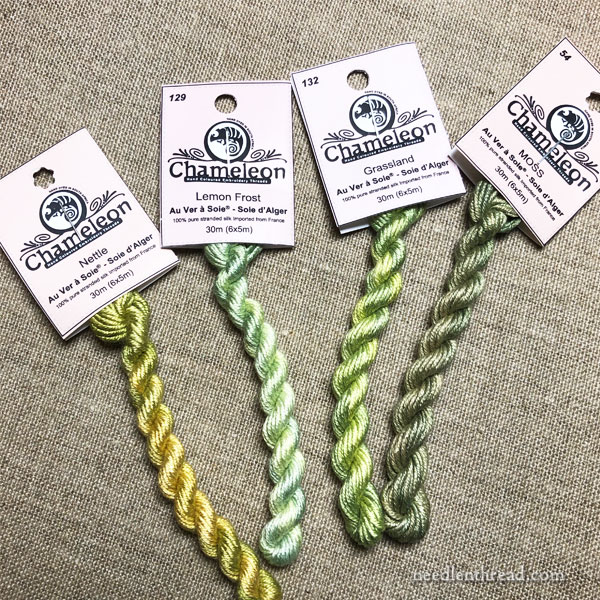
Chameleon’s Soie d’Alger comes in 30 meter twists. The overdyed colors that I’ve tried out are softly blended together, and the overdyed effect comes across very subtly.
The Soie d’Alger, which is a softly twisted, spun silk, retains its natural sheen in the dyeing process, so that the resulting embroidery has a soft sheen and a beautiful “spread” from the softly twisted fibers.
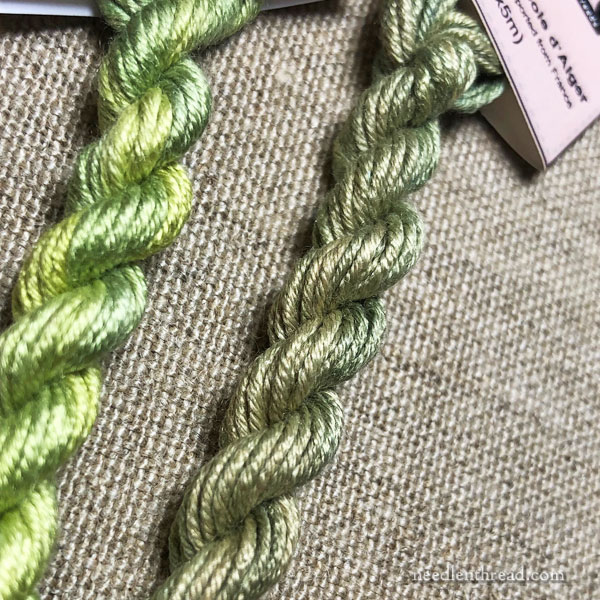
Soie d’Alger is a stranded, spun silk. Each of those thickish “ropes” of embroidery floss you see within the whole twist in the photo above can be separated into seven strands that can be used individually or recombined with any number of strands.
So while each twist comes with 30 meters of thread, if you are only stitching with one strand, you really have 7 x 30 (210) meters of silk to stitch with. If you’re stitching with two strands, you’ve got 105 meters, and so forth.
Stranded silk like this handles pretty much like stranded cotton, so it’s an excellent silk for beginners. You strip the individual strands apart and put them back together to stitch with, just as you do with cotton floss. (You can read about how to strip or separate floss – and why – here, if you’re unfamiliar with the concept.)
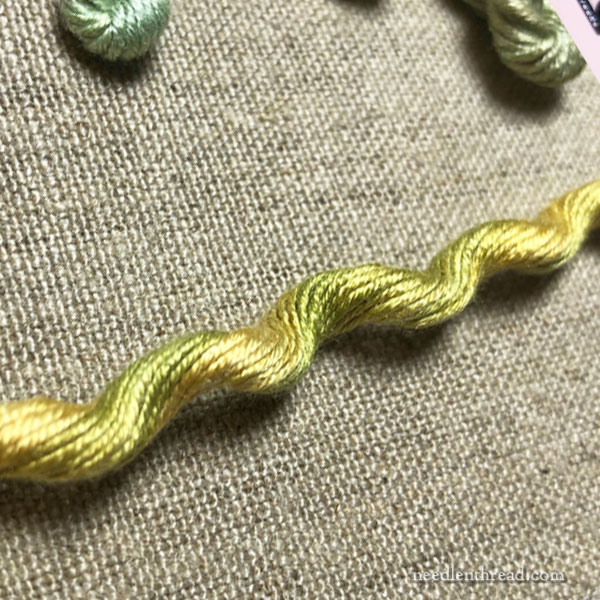
As I began to take the first twist apart, I was, admittedly, a little disappointed that the thread is put up in tight twists, so that, even when untwisted, the thread retains some kink.
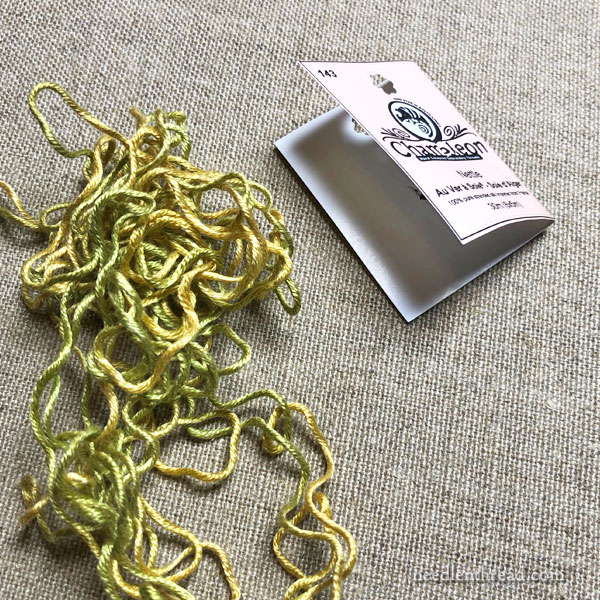
This can be a little annoying. I opened the whole twist up and ended up having to cut it into usable lengths (which I don’t like to do when working with overdyed threads, because it gives me less control over color placement), just so I could keep the thread tame.
So I opened the whole twist out into a ring and then cut the ring to give me workable lengths of thread.
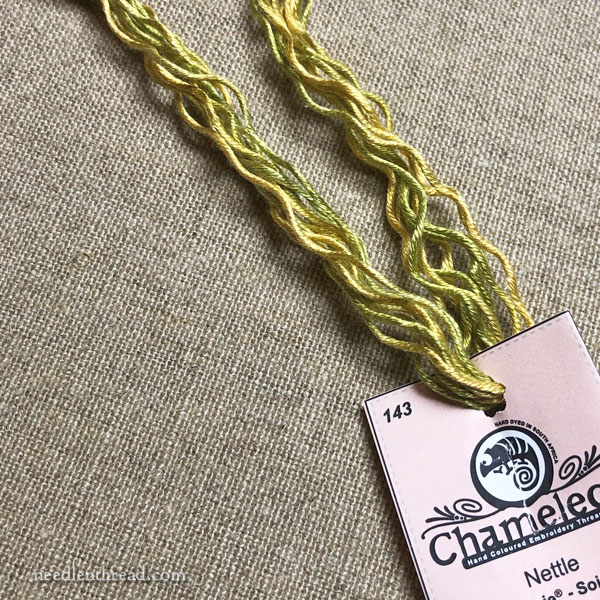
These, I strung back into the paper tag, so that I kept the information for each color with the correct thread.
The threads look a bit like ramen noodles.
But – once you start using them, they work fine!
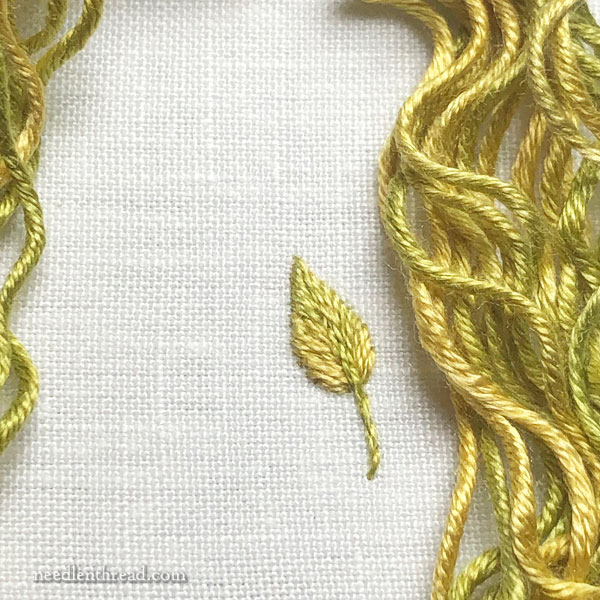
I really enjoyed stitching with the very subtle color changes on this overdyed silk. The little leaf in the above photo is embroidered with long and short stitch, with a stem stitch down the center for the vein.
With this particular color, I ended up with a golden leaf with a green tint, with the colors blending together really well even in a small space. There’s a hint of a color combination going on, without any bold striped effect or any distinct color patches.
Being Soie d’Alger, I’m predisposed to like stitching with the threads, anyway, but what really sells me on them is the very subtle overdyed effect. They’re really beautiful threads! I may have to explore other color combos…
As far as washability, according to the Chameleon Threads packaging, the silks can be washed in cool water. I always recommend testing threads first, though, before using them on a major project – especially when working with overdyed embroidery threads.
Where to Find Them
If you are in the US, you’ll find silk Chameleon Threads available through The French Needle, where they are arranged in four-twist color collections.
In the UK, you can find the whole collection of Chameleon Threads through Lorna Bateman, who uses the threads in her designs.
If you’re in Australia, All Threads carries the range of silks and cottons.
Chameleon Threads has their own website, but I’m not sure how well it’s kept up to date. Every time I check it, there are photos missing, including their logo in the header. Still, if you want to check out their lovely color collections and some projects worked with their threads, take a look at their Gallery here. Worth a meander!







Morning Mary ~ What a tempting and delightful article, I totally enjoy working with subtle shading in just about any color you can think of and silk, with its sheen would make it doubly enjoyable. I also love collecting overdyed and shaded threads but have no idea how to stitch with them. Just going to have to jump in the deep end I guess and see what happens with experimenting. After morning chores, I’ll be reviewing my line drawings and patterns in my files to find ‘the’ project to experiment with. What a fun carrot that will be.
Happy stitching ~ Brenda
Just curious if the twisted thread is a problem, can it be ironed? …thinking this: lay the untwisted hank on a fluffy towel, spritz it with a little distilled water and then iron with a silk setting. Would it compromise the integrity of the fibers?
Thank you, Mary for introducing your readers to this beautiful thread. I have never heard of Cameleon Threads. I am wondering if anyone has done a color conversion chart?
If anyone is looking for a Canadian supplier of these threads you can find them at Embroidery Marketplace
https://embroiderymarketplace.ca/collections/chameleon-threads
I was delighted when Lisa got Chameleon threads in and my experience is similar to yours, but I do find that some skeins are so tightly wound that the threads tangle easily. I am stitching with two strands.
You might try steaming the untwisted skein to get rid of the waves. Possibly with a very light tension on it if it doesn’t relax with just steam alone. Hot, wet silk fibers can stretch, so you wouldn’t want more tension than was necessary to keep them straight. They’ll probably just relax, though, if you hold (or hang) the skein over steam for a bit.
I recently had the opportunity to use Chameleon over-dyed pearl cotton threads on a couple of Lorna Bateman projects. The colours are beautiful, perfect for florals, and I like the subtlety of the variegation.
I might have to check out the silks!
Dear Mary
These look lovely and as I use Soie d’Alger threads a lot these would be lovely to stitch with and I I’m glad they have retained the sheen of the thread and that I can buy them in the UK definitely a plus. As you point out the only thing wrong with them is the thread retains some kink, but they are lovely. Thank you for sharing the new Chameleon Soi d’Alger threads with us and for the photos of the stitched leaf using the thread I will definitely be purchasing them at some stage.
Regards Anita Simmance
Missing link?
(You can read about how to strip or separate floss – and why – here, if you’re unfamiliar with the concept.)
Oooh, such enticing shades! Especially the green-gold! I must try these some day!
I have recently purchased my very first silk thread – Soie d’Alger, according to your advise for beginners 🙂 – and begun to stitch with it. First thing I noticed was the twist the thread retains after stripping it off the skein. It is normal Soie d’Alger from Au Ver à Soie, so the state of the threads in your photo didn’t strike me at all – maybe yours are still more twisted than the “pure” version? I can’t gauge. The gentle twist doesn’t bother me at all, it doesn’t interfere while working. I just believed it to be a peculiarity of (spun?) silk.
Any twisted silk, really… but you can counteract it easily with Soie d’Alger by being aware of your needle turning as you stitch – if it habitually turns, then roll it slightly in the opposite direction between every stitch or so.
These threads appear luscious I will try them